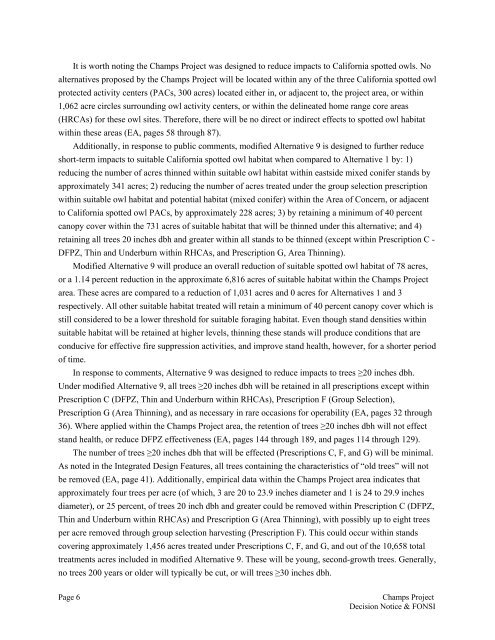Champs Project
Champs Project
Champs Project
Create successful ePaper yourself
Turn your PDF publications into a flip-book with our unique Google optimized e-Paper software.
It is worth noting the <strong>Champs</strong> <strong>Project</strong> was designed to reduce impacts to California spotted owls. No<br />
alternatives proposed by the <strong>Champs</strong> <strong>Project</strong> will be located within any of the three California spotted owl<br />
protected activity centers (PACs, 300 acres) located either in, or adjacent to, the project area, or within<br />
1,062 acre circles surrounding owl activity centers, or within the delineated home range core areas<br />
(HRCAs) for these owl sites. Therefore, there will be no direct or indirect effects to spotted owl habitat<br />
within these areas (EA, pages 58 through 87).<br />
Additionally, in response to public comments, modified Alternative 9 is designed to further reduce<br />
short-term impacts to suitable California spotted owl habitat when compared to Alternative 1 by: 1)<br />
reducing the number of acres thinned within suitable owl habitat within eastside mixed conifer stands by<br />
approximately 341 acres; 2) reducing the number of acres treated under the group selection prescription<br />
within suitable owl habitat and potential habitat (mixed conifer) within the Area of Concern, or adjacent<br />
to California spotted owl PACs, by approximately 228 acres; 3) by retaining a minimum of 40 percent<br />
canopy cover within the 731 acres of suitable habitat that will be thinned under this alternative; and 4)<br />
retaining all trees 20 inches dbh and greater within all stands to be thinned (except within Prescription C -<br />
DFPZ, Thin and Underburn within RHCAs, and Prescription G, Area Thinning).<br />
Modified Alternative 9 will produce an overall reduction of suitable spotted owl habitat of 78 acres,<br />
or a 1.14 percent reduction in the approximate 6,816 acres of suitable habitat within the <strong>Champs</strong> <strong>Project</strong><br />
area. These acres are compared to a reduction of 1,031 acres and 0 acres for Alternatives 1 and 3<br />
respectively. All other suitable habitat treated will retain a minimum of 40 percent canopy cover which is<br />
still considered to be a lower threshold for suitable foraging habitat. Even though stand densities within<br />
suitable habitat will be retained at higher levels, thinning these stands will produce conditions that are<br />
conducive for effective fire suppression activities, and improve stand health, however, for a shorter period<br />
of time.<br />
In response to comments, Alternative 9 was designed to reduce impacts to trees ≥20 inches dbh.<br />
Under modified Alternative 9, all trees ≥20 inches dbh will be retained in all prescriptions except within<br />
Prescription C (DFPZ, Thin and Underburn within RHCAs), Prescription F (Group Selection),<br />
Prescription G (Area Thinning), and as necessary in rare occasions for operability (EA, pages 32 through<br />
36). Where applied within the <strong>Champs</strong> <strong>Project</strong> area, the retention of trees ≥20 inches dbh will not effect<br />
stand health, or reduce DFPZ effectiveness (EA, pages 144 through 189, and pages 114 through 129).<br />
The number of trees ≥20 inches dbh that will be effected (Prescriptions C, F, and G) will be minimal.<br />
As noted in the Integrated Design Features, all trees containing the characteristics of “old trees” will not<br />
be removed (EA, page 41). Additionally, empirical data within the <strong>Champs</strong> <strong>Project</strong> area indicates that<br />
approximately four trees per acre (of which, 3 are 20 to 23.9 inches diameter and 1 is 24 to 29.9 inches<br />
diameter), or 25 percent, of trees 20 inch dbh and greater could be removed within Prescription C (DFPZ,<br />
Thin and Underburn within RHCAs) and Prescription G (Area Thinning), with possibly up to eight trees<br />
per acre removed through group selection harvesting (Prescription F). This could occur within stands<br />
covering approximately 1,456 acres treated under Prescriptions C, F, and G, and out of the 10,658 total<br />
treatments acres included in modified Alternative 9. These will be young, second-growth trees. Generally,<br />
no trees 200 years or older will typically be cut, or will trees ≥30 inches dbh.<br />
Page 6 <strong>Champs</strong> <strong>Project</strong><br />
Decision Notice & FONSI
















